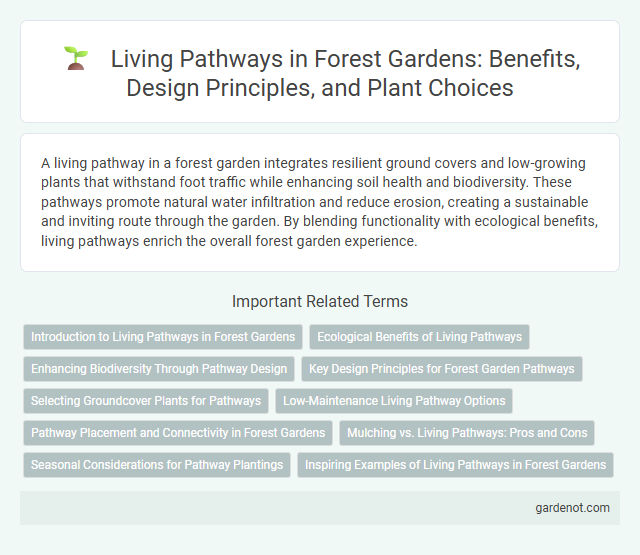A living pathway in a forest garden integrates resilient ground covers and low-growing plants that withstand foot traffic while enhancing soil health and biodiversity. These pathways promote natural water infiltration and reduce erosion, creating a sustainable and inviting route through the garden. By blending functionality with ecological benefits, living pathways enrich the overall forest garden experience.
Introduction to Living Pathways in Forest Gardens
Living pathways in forest gardens are carefully designed routes that promote soil health, biodiversity, and easy access without compacting the ground. These pathways consist of resilient plants and mulch layers that support beneficial insects and micro-organisms while guiding foot traffic sustainably. Incorporating living pathways enhances ecosystem function and contributes to the overall productivity and resilience of forest garden systems.
Ecological Benefits of Living Pathways
Living pathways in forest gardens significantly enhance soil health by increasing organic matter and promoting microbial diversity. These vegetated walkways reduce soil erosion, improve water infiltration, and create microhabitats for beneficial insects and pollinators. Integrating living pathways supports biodiversity and strengthens ecosystem resilience within permaculture designs.
Enhancing Biodiversity Through Pathway Design
Living pathways in forest gardens serve as dynamic habitats that enhance biodiversity by integrating native plants, fungi, and insect-friendly ground covers. Designing pathways with varied textures, elevations, and microclimates supports diverse species, promoting ecological balance and resilience. Incorporating organic mulches and porous materials aids soil health, water retention, and creates microhabitats essential for beneficial organisms.
Key Design Principles for Forest Garden Pathways
Living pathways in forest gardens emphasize natural materials that harmonize with the ecosystem, such as mulch, wood chips, or decomposed granite to enhance water permeability and soil health. Key design principles include maintaining a narrow width to minimize disturbance, ensuring paths follow natural contours for erosion control, and incorporating native plants along edges to support biodiversity and create seamless integration with garden zones. These pathways facilitate human access while promoting sustainability and resilience within the forest garden environment.
Selecting Groundcover Plants for Pathways
Selecting groundcover plants for living pathways involves prioritizing species that are durable, low-maintenance, and capable of withstanding foot traffic. Ideal choices include creeping thyme, white clover, and Irish moss, which provide a dense, nitrogen-fixing, and visually appealing carpet while improving soil health. These plants enhance pathway resilience, reduce erosion, and contribute to the overall biodiversity and functionality of a forest garden ecosystem.
Low-Maintenance Living Pathway Options
Low-maintenance living pathways in forest gardens utilize natural materials like mulch, wood chips, or gravel to create durable, permeable surfaces that reduce weed growth and soil compaction. These pathways support biodiversity by encouraging beneficial fungi and microbes while requiring minimal upkeep such as occasional topping or debris clearance. Durable options like reclaimed timber or stone slabs blend seamlessly into the ecosystem, promoting sustainable, eco-friendly garden navigation.
Pathway Placement and Connectivity in Forest Gardens
Optimal pathway placement in forest gardens ensures efficient access to diverse plant zones, enhancing maintenance and harvest activities while minimizing soil compaction. Strategically connecting key areas like planting beds, water sources, and compost sites promotes seamless movement and supports sustainable garden management. Thoughtful pathway connectivity also facilitates biodiversity by allowing beneficial organisms to travel freely across the garden ecosystem.
Mulching vs. Living Pathways: Pros and Cons
Living pathways in forest gardens offer biodiversity benefits and improved soil health by promoting microorganism activity and reducing soil compaction. Mulching pathways provide moisture retention and weed suppression but may require regular replacement and can restrict foot traffic during wet conditions. Choosing between living pathways and mulch depends on site-specific goals, maintenance capacity, and long-term ecosystem impact.
Seasonal Considerations for Pathway Plantings
Living pathways in a forest garden thrive when seasonal variations guide plant selection, ensuring year-round resilience and visual interest. Opt for hardy groundcovers like creeping thyme and native sedges that withstand frost while promoting soil health during dormant periods. Incorporate flowering perennials such as wild violets and creeping phlox to provide early spring blooms, enhancing microhabitats and supporting pollinators throughout changing seasons.
Inspiring Examples of Living Pathways in Forest Gardens
Living pathways in forest gardens serve as dynamic, self-sustaining walkways that blend seamlessly with surrounding vegetation, promoting biodiversity and soil health. Examples like the permaculture designs in Yorkshire, UK, showcase pathways enriched with nitrogen-fixing plants and aromatic herbs that deter pests while supporting beneficial insects. These pathways exemplify multifunctional design principles, enhancing both accessibility and ecological resilience in forest garden systems.
Living pathway Infographic

 gardenot.com
gardenot.com